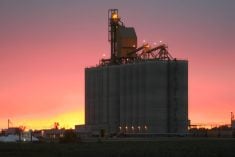As the Canadian pork industry faces a do or die crossroads, it is asking for the support of the Canadian agriculture industry, Canadian consumers and the federal government for a recovery plan to be implemented over the next five years.
The plan, reported to be worth about $800 million, isn’t asking for grants or direct cash bailouts, but rather a three pronged approach that includes a special H1N1 Recovery Plan Loan, adjustments to the Advance Payments Program emergency advances and a Hog Farm Transition Payment Program.
Read Also

Cancer agency reclassifies another herbicide ‘probably carcinogenic’
The WHO’s cancer research agency has now put atrazine, a herbicide well known to corn growers, in the same potential-hazard category where the agency put glyphosate.
The package, which calls for downsizing the Canadian hog industry, is in front of Federal Agriculture Minister Gerry Ritz and some decision is expected within the next few weeks.
The hog industry is in the midst of a dilemma that isn’t new to Canadian beef producers. The industry has had three tough years of low markets and high feed and other input costs. With hopes that 2009 might be a turn around year, along comes the H1N1 flu pandemic (unfortunately dubbed the Swine Flu) and that has simply knocked the hell of out markets. While pretty well everyone in the agriculture industry knows you can’t get H1N1 flu from eating pork, anymore than you can get chicken pox from eating a plate of BBQ wings, some countries and consumers haven’t let facts and common sense get in the way of their decision not to buy pork.
Hog producers, right now, are losing about $50 on every market hog they sell. Peter Entz, a director of Alberta Pork Producers, who is a member of the Stettler Hutterite Colony, says with hogs selling for $1.19/per pound (mid July) and their breakeven price somewhere around $1.50 to $1.60 per pound, they (the industry) simply can’t go on much longer. The Stettler colony has 12,000 head of hogs in the barn. And Hutterite colonies are among the lowest cost producers.
Most livestock and crop producers, either with good planning or good bankers, have figured out systems to weather the occasional storm –whether it be a poor growing season, low markets, or volatile input costs. But everyone has a limit. You can only lose money for so long. Canadian pork producers are at a point, if they don’t get some assistance to carry them through this H1N1 flu crisis many will simply be forced to empty the barn.
Key points of the H1N1 Recovery plan loan include:
-hog producers will be advance a first draw on the program of $30 per market hog shipped in the first quarter of 2009, with all subsequent payments based on previous quarter shipments.
-A formula would be established based on average provincial costs of production.
-For the third and subsequent quarters producers would receive a payment based on average provincial prices minus average provincial cost of production.
-The loan program continues until average provincial prices return to pre H1N1 levels.
The key point of the Adjustment to the Advance Payment Program:
-The current emergency advances are required to be re-paid in September 2010. It is proposed these loans be termed out over a 10 to 15 year period, allowing producers to manage the repayment schedule. In addition by moving these loans off the Advance Payments Program balance sheet, a second year of emergency advances could be provided.
The key point of the Hog Farm Transition Payment program:
-For farms that have managed to stay in business but no longer see a profitable future, assistance to move out of hog production is needed. Since many producers who have hung in this long have lost much of their farm equity, the plan proposes a per sow payment of $500, plus the market value of the animal as a payment as they exit the business. Producers would agree to keep barns free of breeding animals for three to five years.
If these programs fall into place, the pork industry hopes over the next five years to see the industry downsize, in some respects, and at the same time increase domestic pork consumption. Key points include:
-domestic disappearance (consumption) of Canadian pork increase to 730,000 tonnes up about 150,000 tonnes from 2008.
-Exports of live hogs to the U. S. drop about 60 percent, to about four million live hogs, which is 5.3 million head fewer than 2008
-Total pork exports of one million tonnes, with 20 percent going to the U. S.
-Total domestic slaughter of 21.5 million head, which is a reduction of about 200,000 fewer animals from 2008.
-A reduction in total production from 31 million head in 2008 to 25.5 million head.
-A domestic market share of 88 percent compared with 75 percent in 2008.
RECESSION ENDING
As Alberta pork producers hosted a rally in downtown Calgary, July 10 to garner public support for a struggling hog industry, a few blocks away at the International Livestock Conference (ILC), beef producers were learning that there is light at the end of the recession tunnel.
Glen Hodgson, senior vice-president and chief economist of the Conference Board of Canada, told about 250 ranchers and ag industry representatives, Canada should see some modest economic growth by the end of 2009, continuing into 2010.
Hodgson, who described it as a “joyless recovery” warned that it will be a long, slow crawl back toward a strong economy over the next two to three years. He said unemployment figures, which often lag behind a strengthening economy, could hit 10 percent or higher in Canada, before the recession is over.
As world governments have implemented programs to stimulate the stalled economy, Hodgson noted the U. S. is forecasting a staggering $1.8 trillion deficit this year due to economic stimulation programs and another $1.3 trillion deficit in 2010. He says it may be necessary spending to restart the U. S. economic engine, but at some point U. S. taxpayers will have to pay it back.
Pointing to the strength of Canada’s banking industry, which has helped to bring stability to the Canadian economy, and did not require any bailouts as seen elsewhere in the world, Hodgson noted Canada’s 2009 deficit is estimated at $50 billion.
While the U. S. will remain a major economic force in the future, the countries that will actually be the main economic drivers over the next few years will be the “BRIC countries” which includes Brazil, Russia, India and China. Mexico is in there too but “M” did not fit well in the acronym.














